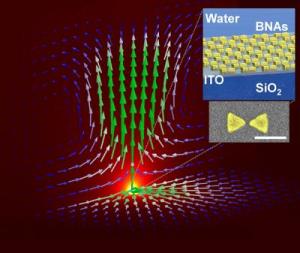Researchers at the University of Illinois at Urbana-Champaign have developed a new theoretical model that explains macroscale fluid convection induced by plasmonic (metal) nanostructures. Their model demonstrates the experimentally observed convection velocities of the order of micrometers per second for an array of gold bowtie nanoantennas (BNAs) coupled to an optically absorptive indium-tin-oxide (ITO) substrate.
 This is a depiction of the fluid convection (arrows) overlaid on the background temperature distribution produced by the BNAs and ITO. The inset shows the BNA geometry with a (false color) scanning electron microscope image of a single bowtie; scale bar is 200 nm.Credit:University of Illinois
This is a depiction of the fluid convection (arrows) overlaid on the background temperature distribution produced by the BNAs and ITO. The inset shows the BNA geometry with a (false color) scanning electron microscope image of a single bowtie; scale bar is 200 nm.Credit:University of Illinois
"Plasmonics offers numerous opportunities to control fluid motion using light absorption," explained Kimani Toussaint, an associate professor in the Department of Mechanical Science and Engineering (MechSE) at Illinois. "The common understanding in the literature is that the observation of micron/s particle motion in plasmonic tweezers experiments can be accurately modeled if one increased the number of nanostructures—for example, nanoantennas—in the array. We showed that this alone would not explain the phenomena. The ITO is the critical piece to the puzzle,"
"This first collaborative study opens doors to investigate phenomena such as particle separation, nanobubble generation, and optical switching. Computations provide a complementary approach to laboratory observations," said MechSE emeritus professor Pratap Vanka, a co-author of the study. Results of the plasmon-induced convection research, with electrical and computer engineering graduate students Brian Roxworthy and Abdul Bhuiya, have been published in the January issue of Nature Communications.
"This work is the first to establish both theoretically and experimentally that micron/s fluid velocities can be generated using a plasmonic architecture, and provides important insight into the flows affecting particle dynamics in plasmonic optical trapping experiments. And our system can be integrated into microfluidic environments to enable greater dexterity in fluid handling and temperature control," Roxworthy said. The work was funded by the National Science Foundation.
The model uses a set of coupled partial differential equations describing the electromagnetic, heat-transfer, and fluid mechanics phenomena, which is solved using COMSOL Multiphysics, a commercial software package. In the study, gold BNAs are illuminated by 2.5 mW of laser light at three different wavelengths, whereby each wavelength corresponds to be on-, near-, or off-resonance with respect to the plasmon resonance wavelength of the BNAs. A solution containing dielectric, spherical particles with diameters of 1 to 20 microns are placed on the BNAs and used to trace the generated fluid flows.
The development of the model led the researchers to several important conclusions. It allowed them to understand the high-velocity particle motion observed in experiments with plasmonic tweezers, and they realized that inclusion of an ITO layer is critical in distributing the thermal energy created by the BNAs—a fact that has previously been overlooked. Additionally, they found that the ITO alone could be used as a simple, alternative route to achieving fluid convection in lab-on-a-chip environments. The researchers also observed that the plasmonic array alters absorption in the ITO, causing a deviation from Beer–Lambert absorption.